Step by Step on The Way of Saint James
From Foncebadón to Ponferrada
3 June 2018
Stage 24 – Km. 27

The first part of today’s stage (about one-third) will still involve climbing; for the rest, the route will be a long and steady descent, lowering our altitude by approximately one thousand metres.
Yesterday’s walk didn’t cause any pain in my legs, and this morning I feel in good shape. However, knowing that joints are more strained during descents than climbs, I decide once again not to carry any weight and entrust the transport of my backpack to the courier.
In the hostel, breakfast is prepared starting at 6:30, so today we set off at 7:00—half an hour later than our usual departure time.
As we start walking (it’s me, Rocco, Giulia, and Giovanna), the sun is rising. The sky is clear, promising a beautiful day.
The temperature is a bit chilly, but after all, we are in the mountains.
As we advance and climb higher, we find ourselves enveloped in an increasingly thick fog.
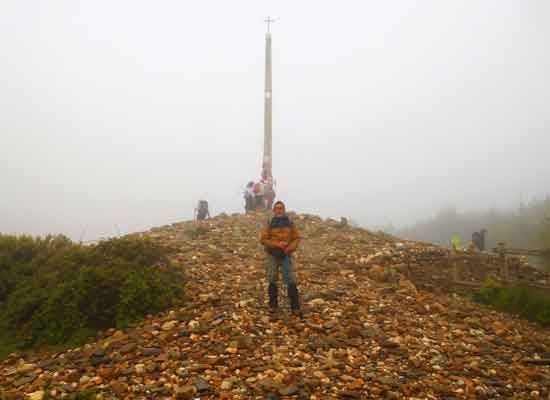
After a couple of kilometres, we reach the Cruz de Hierro, where, fortunately, the mist isn’t dense enough to obscure what is one of the most awaited and significant symbols of The Way of Saint James.
Situated at an altitude of 1,504 metres, the Cruz de Hierro is nothing more than a tall wooden pole, about five metres high, topped by a simple iron cross—replica of the original preserved in the Museum of The Way of Saint James in Astorga.
It’s unclear who erected the monument. Most likely, it was built in the 12th century by a French hermit named Gaucelmo.
Perhaps, the purpose of placing the cross so high was to show the way to pilgrims. In this challenging stretch of The Way, without clear and continuous markers, it must have been difficult to find the path in the past—especially in winter when snow covered all traces.
At the base of the pole is a mound of stones, each left by pilgrims who have passed by over the centuries.
Tradition says the stone should come from one’s place of origin, and the gesture is accompanied by a short prayer:
“Lord, may this stone, symbol of my efforts along the pilgrimage, which I leave at the foot of the cross of the Saviour, weigh in favour of my good intentions on the day when all my life’s purposes are judged.”
I, too, aware of this tradition, set out from home not with one stone but with two.
In reality, they are small pebbles—one a bright blue and the other light brown with dark streaks.
They come from the Amalfi Coast and were chosen by my partner—or rather, the pebbles chose her. After returning home from the beach and taking a shower, she still found them stuck to her shoulder.
Their tenacity in clinging on, defying the laws of physics, seemed to her an unmistakable sign: these were the stones I should carry here.
With a touch of emotion, I let the pebbles fall at the foot of the cross, making sure they sink as far down as possible beneath the larger stones on the surface.
My hope is that they will remain protected for an infinite amount of time, perhaps as long as the world exists.
At the same time, I like to think that the stone pile at the base of the Cruz de Hierro is a precious chest preserving pure and unconditional love.
With the mystical part concluded, there is another ritual to carry out: taking commemorative photos to capture the arrival at the Cruz de Hierro.
Despite the fog, which still allows for decent shots, we all take countless photos—alone, in groups, with strangers, and with close friends.
Cameras are passed around continuously, ensuring we capture every possible combination.
***
In reality, the highest point of the entire French Way, reaching 1,531 metres, is just beyond the Cruz de Hierro, near a communications antenna—a modern symbol of “routes” and connections.
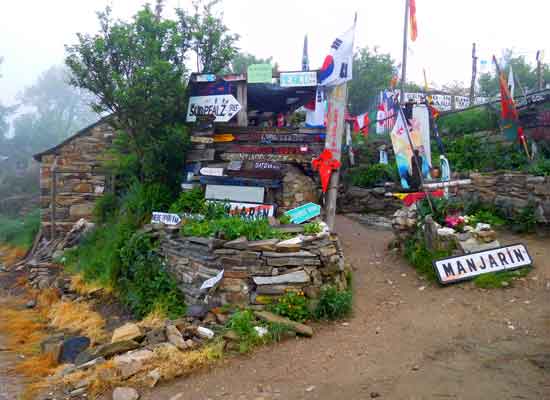
Continuing, the route stays at a fairly high altitude.
After about forty minutes of walking, we arrive at Manjarín—a completely ruined and uninhabited village, home to the most Spartan accommodation on The Way.
Tomás Martínez de Paz is the pilgrim who, starting in 1993, created this small refuge with about thirty-five beds.
He describes himself as “the last of the Templars,” and his mission is to serve pilgrims.
The welcome here is undoubtedly warm, but one must bear in mind that beyond this warmth, there’s nothing else “warm.” Basic modern comforts like electricity and running water are absent.
Like everyone else passing through, we take the chance to snap a few photos of the colourful exterior.
The vividness of the place comes from flags of various nations, symbols, and signs of all kinds—especially a series of directional arrows indicating the distances from Manjarín to various places worldwide: Rome, 2,475 km; Jerusalem, 5,000 km; Machu Picchu, 9,453 km, and more.
But the sign we’re most interested in right now is undoubtedly the one pointing to Santiago de Compostela, which reads 222 km.
Seeing the remaining kilometres shrink always fills me with pride and gives me the strength to continue.
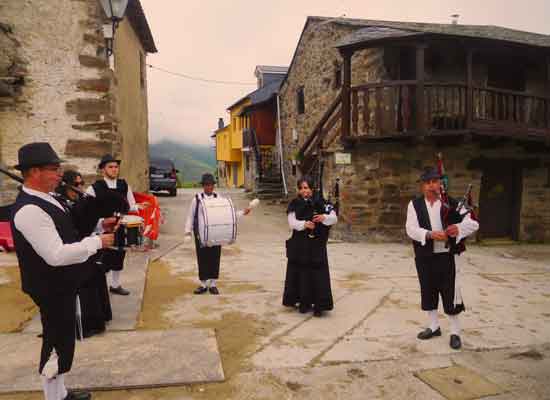
After an hour’s walk from Manjarín, the path begins to descend.
After another hour, we arrive at El Acebo. The village marks the beginning of the Bierzo, a natural region located in the province of León.
El Acebo features charming slate houses with wooden balconies adorned with geraniums in various colours.
The main church, dating back to the 12th century and built in Romanesque style, is dedicated to the patron saint Miguel Arcángel. Inside, there is a polychrome statue of Saint James.
As we walk along the main street, a small band of musicians, dressed in traditional costumes, celebrates “Corpus Christi.” The sound of bagpipes and drums fills the air with joy, encouraging onlookers to dance freely.
It is around 11:00 when we leave El Acebo.
The exit from the village is marked by a sad monument made of wrought iron, dedicated to a German pilgrim, Heinrich Krause, who died here in 1987 following a fall from his bicycle.
The monument, besides being commemorative, also serves as a reminder for cyclists to exercise the utmost caution on the steep and rugged descent.
The next stretch, leading to our destination, is mixed and characterised by various types of terrain: asphalt; dirt paths; rocky sections. In some places, the ground is also uneven and slippery.
This part of The Way offers a more barren landscape, and the absence of tall vegetation often allows an unobstructed view of the valley below.
Along the way, we pass through Riego de Ambros, another quaint village with stone houses similar to those we’ve seen before.
Further along, we walk for a while accompanied by a young pilgrim who entertains us by playing a small guitar.
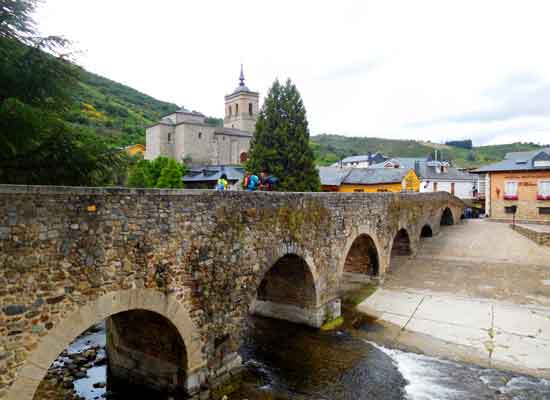
At 13:00, we arrive in Molinaseca.
At the entrance to the village, there is the sanctuary of Nuestra Señora de las Angustias, a 12th-century baroque-style church, and the Puente de los Peregrinos, a monumental Romanesque bridge spanning the Río Meruelo.
The village is relatively large, with about 800 residents.
The architecture of the buildings still reflects the distinct Bierzo style.
Today is Sunday, and the town centre is bustling—not only with pilgrims but also with tourists and many locals.
The peaceful and welcoming atmosphere we experience here in Molinaseca encourages us to take a short break.
At 13:45, we resume walking.
We have six more kilometres to cover before reaching our destination.
The descent has taken us much longer than usual due to the rugged terrain; however, from this point onwards, the path is flat and paved, allowing us to proceed at a faster pace.
At 15:00, we complete today’s stage in Ponferrada, stopping at the Albergue de peregrinos San Nicolás de Flue.
The hostel is slightly on the outskirts, but its distance from the city centre is compensated by its excellent facilities and the fact that accommodation is free.
Of course, as is customary on The Way, when something is provided free of charge, it is understood that a “donation” is appreciated. In the end, what we give makes the stay cost about the same as other hostels with fixed prices.
The setup is very comfortable. Rocco, Giulia, Giovanna, and I are assigned a four-bed room, just for us.
The spacious dining area with a kitchen and the terrace/garden, where many are enjoying today’s sunshine, add to the warm welcome.
Following the directions of the “hospitaleros,” we retrieve the backpacks we sent ahead this morning from a bar located beyond the large car park in front of the hostel.
Around 17:00, Rocco and I set out to explore the key sights of the city’s historic centre.
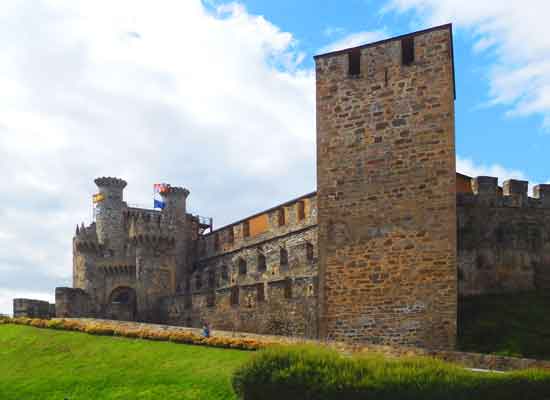
Ponferrada is the last major city before reaching Santiago de Compostela.
It gained fame in the 12th century as the most important stronghold of the Templar knights in Spain and is characterised by its splendid and well-preserved medieval centre.
An ancient iron bridge, built over the Río Sil to facilitate pilgrims’ passage, inspired the city’s name, which derives from “Pons Ferrata.”
From the Plaza del Ayuntamiento, where the baroque-style Town Hall stands, we enter the historic centre through the Arch of the Clock Tower.
A little further on, the Plaza de la Virgen de la Encina opens up, overlooked by the basilica of the same name. Inside the church, there is a statue of the Virgin Mary, which, according to legend, was found by the Templars inside an oak tree (“encina” in Spanish).
However, the most striking feature of Ponferrada is the imposing medieval castle of the Templars, which dominates the historic part of the city from a hilltop.
Its massive crenellated walls, the entrance via a drawbridge, the two towers flanking the main façade, the keep, and the other towers all highlight the
medieval architecture of the fortress, which has reached modern times in excellent condition.
Seen from the outside, it resembles a fairytale castle, where a sad princess might be imprisoned by an ogre in the tallest tower’s dungeon.
During our walk, we also search for a supermarket to buy something to cook this evening. Unfortunately, being Sunday, everything is closed, so we give up the idea of dining at the hostel.
Instead, we have dinner at 4 Bocas, a bar-taperia located in the large and lively Plaza de la Virgen de la Encina, right next to the basilica.
We sit at one of the outdoor tables, but after a short while, as dark clouds quickly cover the sky and heavy raindrops begin to fall, we retreat inside the venue.
| © Aldo Lardizzone 2020 |  |
CREATIVE COMMONS |
Stage 25 - From Ponferrada to Villafranca del Bierzo



